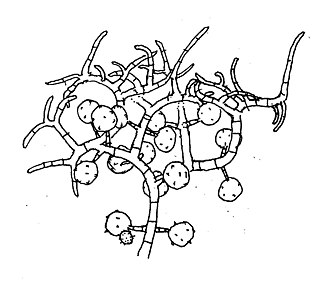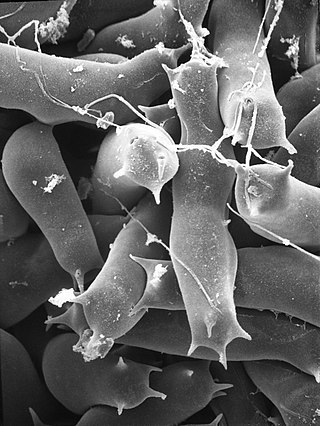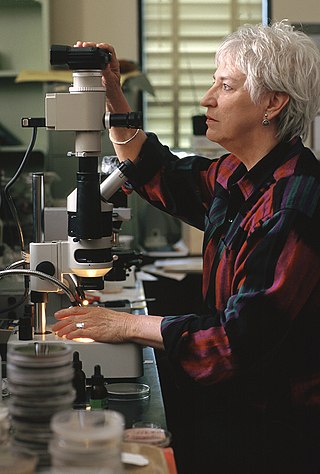Related Research Articles

Eurotiomycetes is a large class of ascomycetes with cleistothecial ascocarps within the subphylum Pezizomycotina, currently containing around 3810 species according to the Catalogue of Life. It is the third largest lichenized class, with more than 1200 lichen species that are mostly bitunicate in the formation of asci. It contains most of the fungi previously known morphologically as "Plectomycetes".

Hygrocybe is a genus of agarics in the family Hygrophoraceae. Called waxcaps in English, basidiocarps are often brightly coloured and have dry to waxy caps, white spores, and smooth, ringless stems. In Europe they are characteristic of old, unimproved grasslands which are a declining habitat, making many Hygrocybe species of conservation concern. Four of these waxcap-grassland species, Hygrocybe citrinovirens, H. punicea, H. spadicea, and H. splendidissima, are assessed as globally "vulnerable" on the IUCN Red List of Threatened Species. Elsewhere waxcaps are more typically found in woodlands. Most are ground-dwelling and all are believed to be biotrophs. Around 150 species are recognized worldwide. Fruit bodies of several Hygrocybe species are considered edible and are sometimes offered for sale in local markets.

The Gomphales are an order of basidiomycete fungi. Some or all families belonging to Gomphales have been sometimes included in the order Phallales, the now-obsolete Ramariaceae was also previously included in Cantharellales. Recent phylogenetic analyses include in Gomphales the families of the original description of the order by Walter Jülich, with addition of Clavariadelphaceae. According to one 2008 estimate, the Gomphales contain 18 genera and 336 species.
Cokeromyces recurvatus is a pathogenic fungus. Described as a new species in 1950, it was isolated from rabbit dung collected in Illinois.

The Mortierellaceae are a family of fungi in the order Mortierellales. The family contains six genera and 93 species.
Pestalopezia is a genus of fungi in the family Helotiaceae. The genus contains three species.
Oevstedalia is a genus of fungi of uncertain placement in the subphylum Pezizomycotina. This is a monotypic genus, containing the single lichen species Oevstedalia antarctica. The genus was circumscribed by Damien Ertz and Paul Diederich in 2004. Previously classified in the Dothideomycetes, Oevstedalia was moved to Pezizomycotina incertae sedis due to the lack of DNA data available for the genus.
Haasiella is a fungal genus in the family Hygrophoraceae. It is a monotypic genus that contains only the species Haasiella splendidissima. Haasiella venustissima, formerly considered to be a distinct species based on its one and two-spored basidia, was found by a DNA study to be synonymous with H. splendidissima. H. splendidissima is only known from Europe and is saprotrophic on wood. Haasiella was described as a new genus in 1966 by Czech mycologists František Kotlaba and Zdeněk Pouzar. It is most closely related to the genus Hygrophorus.
Gregorella is a genus of lichenized fungi in the family Arctomiaceae. This is a monotypic genus, containing the single species Gregorella humida.

The Mixiomycetes are a class of fungi in the Pucciniomycotina subdivision of the Basidiomycota. The class contains a single order, the Mixiales, which in turn contains a single family, the Mixiaceae that circumscribes the monotypic genus Mixia. Only one species has been described to date, Mixia osmundae; this species was originally named Taphrina osmundae by Japanese mycologist Toji Nishida in 1911. It is characterized by having multinucleate hyphae, and by producing multiple spores on sporogenous cells.

Imshaugia is a genus of seven species of foliose lichens in the family Parmeliaceae. They are commonly known as starburst lichens.

The Sigmoideomycetaceae are a family of fungi in the Zoopagales order. The family contain contains three genera, and 4 species. The family was circumscribed in 1992.

Lobosporangium is a fungal genus in the Mortierellaceae family of the Zygomycota. The genus is monotypic, containing the single species Lobosporangium transversale, found in the US and Mexico.

Sutorius is a genus of fungi in the family Boletaceae. Its type species is the widely distributed Sutorius eximius. The Asian Boletus obscureumbrinus, found in Japan and China, was described by Japanese mycologist Tsuguo Hongo in 1968, moved to genus Sutorius in 2016, but then reclassified into genus Neoboletus in 2019. The Australian Sutorius australiensis and the southern Chinese Sutorius subrufus also belong to the genus.
Fischerula is a genus of two truffle-like fungi in the family Morchellaceae. First described from central Italy by Oreste Mattirolo in 1928, the genus name honors Swiss mycologist Eduard Fischer. The type species Fischerula macrospora is known only from Italy, while Fischerula subcaulis is found in coniferous and mixed forests of Oregon and Washington.
Imaia is a fungal genus in the family Morchellaceae found in Japan, and in the Appalachian Mountains of the US. A monotypic genus, Imaia was circumscribed in 2008 by James Martin Trappe and Gábor M. Kovácsto to contain the truffle-like species formerly known as Terfezia gigantea when molecular analysis demonstrated that its DNA sequences were markedly different from those of Terfezia. The fruit bodies of Imaia gigantea are spherical to roughly elliptical to irregular in shape, brown, and usually develop cracks in age. The interior gleba comprises brown pockets of asci separated by white veins. The spores are spherical or nearly so, up to 70 µm long, and enclosed by a thick epispore.
Glaziellaceae is a family of fungi in the order Pezizales that contains the single monotypic genus Glaziella. The type species Glaziella vesiculosa, originally collected in Cuba, was referred to the genus Xylaria by Miles Joseph Berkeley and Moses Ashley Curtis in 1869. A decade later, Berkeley circumscribed the genus Glaziella to contain a specimen collected in Brazil, apparently forgetting that he had earlier named it Xylaria aurantiaca.

Meredith May Blackwell is an American mycologist, known as one of the world's leading experts on fungi associated with arthropods.
Benjaminiella is a genus of fungi belonging to the family Mucoraceae.
Claude Roux is a French lichenologist, mycologist and Esperantist. He has co-authored books about the identification of lichens written in Esperanto.
References
- ↑ "Gamsiella (R.K. Benj.) Benny & M. Blackw. 2004". MycoBank. International Mycological Association. Retrieved 2011-01-15.
- ↑ Kirk PM, Cannon PF, Minter DW, Stalpers JA (2008). Dictionary of the Fungi (10th ed.). Wallingford, UK: CABI. p. 439. ISBN 978-0-85199-826-8.
- ↑ Benny GL, Blackwell M (2004). "Lobosporangium, a new name for Echinosporangium Malloch, and Gamsiella, a new genus for Mortierella multidivaricata". Mycologia. 96 (1): 143–9. doi:10.2307/3761995. JSTOR 3761995. PMID 21148836.
- ↑ Burkhardt, Lotte (2022). Eine Enzyklopädie zu eponymischen Pflanzennamen [Encyclopedia of eponymic plant names](pdf) (in German). Berlin: Botanic Garden and Botanical Museum, Freie Universität Berlin. doi:10.3372/epolist2022. ISBN 978-3-946292-41-8 . Retrieved January 27, 2022.
- ↑ "Gamsiella (R.K.Benjamin) G.L.Benny & M.Blackwell, 2004". www.gbif.org. Retrieved 10 March 2022.